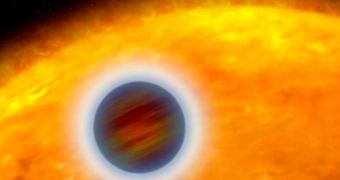Astronomers have produced the first detailed study showing some of the composition and structure of the exoplanet WASP-17b, which has gained notoriety after experts learned that it orbits its parent star backwards, in what is called a retrograde orbit.
The peculiar extrasolar planet was announced back in August 2009. Researchers found it in the system WASP 17, which is located about 1,000 light-years away from Earth.
In all systems discovered thus far to contain exoplanets, all planets, moons and other bodies revolve around the central star in an orbit that has the same orientation as the spin of that star.
This was so far believed to be a basic rule of the way the Universe was set up, but this theory was thrown out the window when this peculiar object was found. Fascinated by it, experts decided to continue investigating it.
Recently, a researcher team based at the Keele University in the United Kingdom used the Chile-based Very Large Telescope (VLT), which is operated by the European Southern Observatory (ESO), to try and make sense of the planet's atmosphere.
This type of studies can be used to determine important characteristics, such as atmospheric composition, light absorption rates, heat distribution on the surface, the timing of eclipses and the radius of the planet itself.
Investigators believed that they could also make sense of the layering of the planet's atmosphere. Given that WASP 17b rotates around its parent star once every 3.74 days, this was easy to do for the VLT>
The observatory was trained on the star system for a few days in June 2009, when it tracked down the exoplanet as it did 8 full swings around the star, Universe Today reports.
A spectrograph analysis of the light was conducted in the sodium doublet lines at 5889.95 and 5895.92 Å, and researchers determined that the chemical exists in small amounts in the planet's atmosphere.
But the work also raised some tantalizing questions, as the absorption rate of light was a lot weaker than researchers had calculated. The formulas were based on a scenarios in which the planet developed from a nebula with solar composition.
WASP 17b apparently has a “sodium-depleted” atmosphere, which is not at all what astronomers expected to find. One possible explanation for this could be that clouds in the upper atmosphere are blocking the light signature of the chemical.
The research team that conducted the new research say that sodium may also be actively eliminated from the planet's atmosphere, and even suggest a mechanism to explain how this happens.
They say that the chemical may be ionized on the day side of the planet, due to the close proximity between WASP 17 and its planet. The substance is then moved through the atmosphere to the other side of the planet, where it is removed.
The sodium would be unable to return to the day side of the planet because WASP 17b is most likely tidally locked with its star, which means that it always keeps the same face oriented towards it.
The planet was discovered through a collaborative effort of astronomers involved in the United Kingdom's Wide Area Search for Planets (WASP) project, and experts at the Geneva Observatory, in Switzerland.
WASP 17b is apparently as heavy as Jupiter, but it is “artificially” inflated to twice its size. That is to say, it is currently orbiting its star on a highly elliptical orbit.
This means that it gets to pass very close to its Sun and then move very far from it. The strong gravitational forces that occur when this happens pull it apart.
“This planet is only as dense as expanded polystyrene, 70 times less dense than the planet we're standing on,” explains Keele University astronomy professor Coel Hellier.

 14 DAY TRIAL //
14 DAY TRIAL //